#lost post
Explore tagged Tumblr posts
Text
Ella focused post-canon long post ahead:
I like the idea of Tadius having to reign Ella in when she has a mean streak towards particular peasants who had perpetuated her abuse in the past. The peasants who verbally and physically taunted/abused her. The people who disregarded her pleas and distress, writing it off as madness, violently sending her back to her abusers just to get her out of their sight. Because her circumstance and uncleanliness was uncomfortable to be around. Maybe she can't stand to be cordial or impartial to the very same people who she watched drag her mother into the square. Or maybe, at her lowest, she says some unpleasant things about all peasantry, flippantly stereotypes them in a moment of temper. Let's her trauma blossom into rage, into a simmering desire (not necessarily action, mind you) for petty cruelty.
We see her deconstruct a lot of her (admittedly not crazy large) bias against peasant and servantry in the show; this being easier for her to accomplish because she was forced into servitude and squalor herself. For example, one of the first things she jabs at Tadius with is his rank as a servant. She establishes her status and her power over his well-being, potentially his life (and this is important for us to see for her character! this is the first time we see her so confident in her dialog in the show. she is finally reclaiming the autonomy, power, and safety she lacked for potential years, even if this isn't "perfect victim" or kind behavior). This threat could easily have been genuinely fear inducing for Tadius if he hadn't perceived her comment as banter/wit (or he, at the very least, thought she couldn't do anything to him as the prince's right hand servant because she's not from a reputable house). But later, we see her call Tadius "a good man" instead of "a good servant", signifying her growth. She acknowledges where she went wrong in the past and asserts Tadius's position as an equal. Textbook character development.
She also originally vows to the fairy godmother to take vengeance only on those who deserve it, who have taken everything from her and seek to destroy more. She makes clear that her blood lust is for specifically her step family (edit: if Justine and Lucy represent Ella's core values and dreams then Justine establishing kindness to those socially lower to them as an admirable trait makes a whole lotta sense for Ellas character going foward). Hell, she is said to be a good queen by the whole kingdom, implying the peasants favor her rule after she's gained it. She is known by all for her kindness and love which is carried out just as fiercely as her justice.
Does this mean she doesn't have low points? Does this mean that at her lowest Tadius doesn't need to council her and advice her against her (valid, but potentially unfair) anger? That she doesn't let her new found power make it so that, at times, she speaks down to those she deems morally lesser (and could that perception of who is lesser, by this measurement, be influenced by class bias/her past peasant inflicted abuse)? Ella's main character motivation is vengeance in the show, even if her morals are steadfast throughout, I think it would be an interesting conflict between Ella's own ethic values vs. her (again, valid) trauma-induced feelings/vitriol, and how that conflict influences her decisions not only as queen, but interpersonally.
This could also lead to some great tension between Ella and Tadius (who are at this point good friends, partners, or at the VERY least close coworkers). With some communication Tadius would be given better insight into Ella's past, interworkings, and decision making. It would also grant Ella an outlet to talk about all this awful shit that happened to her and how it comes back to affect and shape her presently.
Not to mention Tadius's own trauma regarding aristocrats who belittle their subjects. Maybe at her most cruel (aka in a very bad emotional state) Tadius becomes clinical and emotionally disconnected, just as he was with the prince? Unconsciously or not, sinks back into giving stony irritated advice and doesn't talk to Ella in their normal affable manner for the rest of the day, or longer. Maybe it takes them a while to get to the point of healthy communication because of both of their past isolation (ella is purposely isolated by her supposed "madness" and has no one to talk to, she is overjoyed to vent to a literal frog + no one recognized tadius's wit before ella, implying he is not close enough with anyone for them to know who he is personally) makes it difficult for them to talk in a productive manner at first.
(I do not mean to say this is the only interpretation of Ella's character or the headcanons you should adopt post-cc. Maybe Ella never let's these internal biases (that I've picked up on) influence how she treats her subjects/how she rules. Or, shes developed and grown entirely past them. Maybe Ella and Tadius never have this kind of conflict between them. This is also tackling a very specific negative trait I enjoy exploring, which I personally could see presenting itself in Ella post-canon. I love her. I don't doubt she is a great queen who rules with the working class's benefit, along with the rich's detriment, in mind (in fact, I definitely like to believe she does). I just really like characters having character flaws, even if they are a good person, even if they are the hero, and even past their happily ever after)
#sorry to place so much Tadius in an Ella analysis post I hope its not an inappropriate insertion#I just think he's a good frame of reference for Ella's character development#and this post is semi abt analysis mostly abt post-cc headcanon so y'know#let me get a bit ship-y with it#cinderellas castle#ella ashmore#tadius#tadius cc#starkid cc#starkid#team starkid#tadmore#tadella#elladius#lost post#cw abuse#tw abuse#<- just in case#cc spoilers#mine
38 notes
·
View notes
Text
I have been looking for this post for several hours please help
So Danny becomes mayor of Gotham he befriends red hood he also has brain damage so he has trouble with names Jason gets a name plate to stand under
He rates assassination attempts with whatever score he thinks will cause the most chaos
He has a trans woman named honey as his secretary
He does an interview with Conner and says he's going to make no income housing
He meets poison ivy with plans for green spaces they shake hands and she has a minor crisis
Vicky Vale is annoying Danny with interviews a bunch
I think that's all I remember
71 notes
·
View notes
Text
I, once again, lost a fic that I really loved and I need help finding it.
So it’s a Joel Miller fic where he’s traveling with Ellie and reader (possibly a fem oc but I’m pretty sure it was reader) and at one point they have sex and Joel’s like really rough, not knowing it’s her first time, and once he finds out like the next day when she’s in pain in the morning and he’s like “why did you tell me? I wouldn’t’ have just stuck it in there if I had known” and it’s multiple parts, three I think but maybe more, possibly 2 but I’m almost certain it was 3.
#joel miller fluff#joel miller#sorry for all the tags i just want people to see this so i can find it 😭#the last of us#joel miller smut#joel miller angst#ellie williams#pedro pascal#pedro pascal joel miller#age gap joel miller#joel miller age gap#joel miller fanfiction#joel miller x female reader#joel miller x reader#joel miller x reader smut#lost fic#lost post#lost writing
35 notes
·
View notes
Text
Hey if anyone finds the post where clockwork dropped a de-aged jazz, danny and elli/dani as small children onto Dan before punting them to Gotham, with Jason as their neighbor and later step dad/ papa?
Do you mind tagging me or dropping a link to the post?
My phone ate it before i could reblog for later.
If it helps, dan had a breakdown after choosing to be their dad and realized that, and thought he was irredeemable. And jason helped him. Then jason later had a similar breakdown realizing he was choosing to be good despite thinking himself irredeemable.
Thanks
54 notes
·
View notes
Text
rui is intimately familiar with the knowledge that he has the capacity for harm. he knows that the contraptions he makes, the stunts he directs—even if he takes every safety precaution possible—, the chance of somebody sustaining an injury, a minor one, a major one, a lethal one, is absolutely never zero. he’s willing to take that risk. he likes that risk. but he’d never assume that everybody is, and would never blame someone for not being willing to. that’s why companions who trust him and are willing to take that risk in turn are so precious to him. i think he’s also aware of the way he’s seen, a really tall Guy who’s told people to jump out of windows for his amusement and builds bombs on school property, and is aware of his capacity for harm even outside the framework of shows.
i do think he values human life and safety more than average, but more than i think he’s against the concept of harm, i think he absolutely cannot justify himself doing harm. i think he values like all human life and safety over his own, but i think he values the lives and safety of the people he cares about very significantly over that of random shmucks. it’s not quite a matter of being kind without bias, saintlike. he just cares about people comparatively more than he cares about himself. so like, i don’t think he could cope with harming someone that didn’t agree to the risk of being harmed (and even then…), but provided it’s not a situation where he has to reevaluate his view of the person in question entirely (e.g. someone turning out to hurt people for funsies), i don’t think he’d lose much sleep if someone he cared about harmed someone else, beyond perhaps a solemnity and blaming himself for not being able to nip whatever situation led to that in the bud. he just doesn’t hold anyone to the standards he holds himself.
and then re: being harmed… i don’t think there’s a situation (canon-adjacent) where rui can be pushed to retaliate against violence inflicted on him. deterrence, avoidance, sure, but i don’t think he’d ever see an eye for an eye as a viable option because he does not view his flesh to be an equal weight. if there’s someone who wants to hurt, then necessarily there will be someone who gets hurt, and better him than anyone else, cause at least he can take it (stupid). i think he could be pushed into retaliating against violence inflicted on someone else, but i think he’d try literally everything he possibly can to defuse the situation before it comes to that, and post hoc revenge is just not on the table. even being pushed into wanting to, would be a challenge. however, someone retaliating against violence inflicted on them or someone else, i don’t think he’d intervene or find a problem with beyond, again, a solemnity. and like, if he were in a position to, i think he’d hold someone back from unambiguously crossing the line between “defence” and “revenge”, not necessarily in empathy for the perpetrator-cum-victim, but rather because somebody in that situation should keep mind to make things as clean as possible in case of scrutiny under involvement of law enforcement.
things that are done cannot be undone, so revenge is useless, as is punishment. so i don’t think he’d really moralize about taking responsibility to anyone. but if it were him, if he did something he couldn’t take back, no amount of atonement would undo anything, therefore an infinite amount is just as justified as none, so he’d confess and leave his fate in the hands of others because he believes he is anything they think he is. other people in the face of doing something terrible still have the rest of their lives to live, but his is already over.
#god he’s stupid#rambles#sort of a follow up to the mizuki + rui middle school manslaughter post#like my reasoning for why i think he’d make a good accomplice to manslaughter and a shit murderer#lost post#swagposts#murder tw#i guess? in the tags?#uuuuuuh i feel like i should tag this something but idk what. lmk!!
12 notes
·
View notes
Text
Guys Tumblr nuked my post about king Arthur and Merlin rawdogging on Christmas day 2022 and it had like 2000 odd notes so uhhhhhhh here this is it's replacement. King Arthur and Merlin rawdogging on Christmas day 2024 reblog if you agree.
76 notes
·
View notes
Text
There is a post somewhere...
Robin!Tim is holding onto feelings about Titans Tower, and after a team-up with Red Hood and Huntress, kicks Jason in the balls. Huntress takes him for ice cream.
29 notes
·
View notes
Text
Madoka 3.0
So, I was wrong about Tomoe Mami…
The last time I wrote about Madoka Magica (many months ago,oops), I had watched 1.5 episodes and kept reading Mami in a sinister light. Ever since, I’ve watched the whole first three episodes and one whole minute of the fourth before deciding I do want to write down my impressions, after all (I’ll try to do an episode every two or so weeks after this write up, since I find them pretty taxing to craft and post lol). With that out of the way…
Rewatch observations.
There was a lot I didn’t write about last time; it’s such a packed premiere in terms of craft, I’d have never finished if I wrote everything I wanted to note. Even now, I’m compiling only a few new observations from my re-watch of episode one.
So, the first thing is the background design. In terms of architecture and adornment, especially when it comes to the school, it really brings to mind postmodernist spaces. This shot legitimately reminds me to art museums I’ve been to in terms of the open the space with the sculpture of a withering plant encased in a strange cage placed front and center, like in an exhibition, and the open, well-lit rooms with framed pictures on the wall:
[Image description: a wide room filled with students dilly-dallying. It has wide, white panels in the walls, a framed picture by the right edge and a sculptured of a whitering plant encased in a strange cage placed front and center.]

I wonder if Madoka Magica would make for a good excuse to read on post-modern art lol
Funnily enough, the clear panels to their classrooms make their framework stand out, making them look like cages as well:
[Image id: Madoka and Homura, with the latter taking the lead, walking away from the classrooms, placed at the center of the image. They’re framed by classroom walls on both edges of the frame as well as in the background, you can see students peeking outside through the clear panels.]

They also allow for quite the peanut gallery. If one chooses to fully immerse in a gay reading, the exposed feeling as the two of them walk away from the rest of the student body can be quite resonant.
Also, what’s with the cages? I guess I’ll find out eventually.
That aside, and this observation is courtesy of my sister, the background design can also give off a feeling like that of a backroom due the openness and uniformity of the spaces. There can be a sense of infinity and liminality to them, even (think of the corridors Madoka and Homura traverse while walking to the infirmary, for example). This sense of being on the threshold of realization haunts Madoka’s waking up sequences, but it also feels fitting for Homura’s own state of being—her warning to Madoka highlights her preference for stasis, as she tells Madoka that if she were to seek change, she’d lose it all. Now, obviously, this is because Madoka seems doomed to die regardless how many times Homura loops, but it’s also worth bringing up that adolescence is often thought up as an intermediate space between childhood and adulthood, mired with great, uncontrollable change. One could say that the time loop narrative serves to heighten Homura’s teenage anxieties, and it stands in direct contraposition to Madoka’s budding hunger to grow and embrace change. I might be getting ahead of myself here, but Madoka’s wish to change also seems to clash with all the illusory motion present in the first few minutes of this episode—meaning that there’s something inherent to the processual dynamics of being a magical girl that might offer an illusion of advancement but it’s fundamentally at odds with it.
[Image id: A screenshot of Madoka standing in the blue hallway where Homura issues her warning. She’s placed slightly to the right of the center line, and she watches Homura leave, who is placed on top of the point of fugue at the center of the image. The subtitles read: “Stay as you are, and as you always shall be.”]
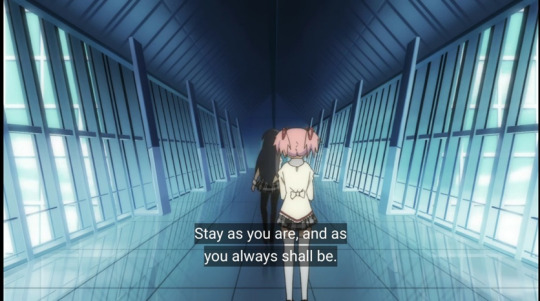
See? The window panels are very evenly spaced and the repetition allows for a sense of infinity. Since Homura is placed over the point of fugue, there isn’t an end in sight for this corridor. The faded colors and details at the back are to create a sense of depth through atmospheric perspective, but for all you know this corridor is endless.
[Image id: A close up to cherry tomatoes still in their stems, attached to the plant. Mr Kaname holds some scissorts to cut one off the plant.]
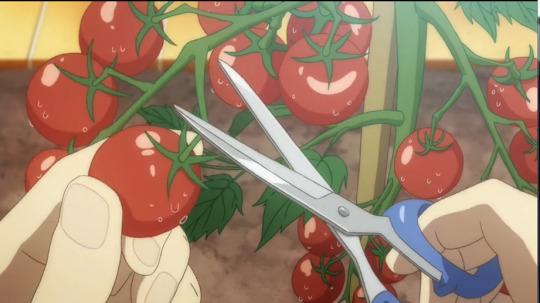
There’s also quite a bit of focus on these cherry tomatoes as we take a peek at Madoka's idyllic home life in episode one. I don’t really know what to make of this lol Are we in the Big O?
The second thing from episode one I want to highlight is Sayaka’s feelings towards Homura. In my first watch, I was very amused by her playing protector to Madoka to really notice, but Sayaka reacts quite jealous of Homura, doesn't she?
[Screenshot showing Hitomi and Sayaka sitting on the same side of the tabe with trays with their lunches before them. Hitomi, sat to the left observes Sayaka, sat to right margin. Sayaka is infuriated, with her hands up in a disgruntled gesture. Her dialogue reads “Just how big of an impression does she have to make on people?”]
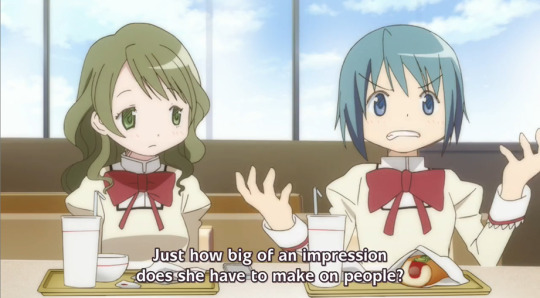
She complains about Homura so much during episode two, it’s hilarious.
She paints it in a jokey manner, but she seems quite frustrated at Homura’s perceived perfection in looks, academics and athletics. Now, I say this because I watched that whole first minute of episode four, (however, it was also teased in the rose-tinted nostalgia for Kamijō’s playing in episode three), but she does legitimately seem to have a complex about her own average-ness compared to prodigies such as Kamijō and Homura. You know, her whole hero shtick does remind me quite a bit to Tenjō Utena’s own princely act, and given that one had a component to building up one’s own ego, I’m genuinely wondering if Sayaka is trying to soothe and elevate herself to compensate for her own sense of inferiority. When I watched episode three, I wanted Mami and Homura to duke it out, but they didn’t, preferring to stall with words. I’m now placing my hopes on you, Sayaka, as your animosity for Homura grows from your protective feelings for Madoka, your anger at her dismissive attitude towards Mami’s death and your gnawing jealousy! I’m rooting for you!
Childish aspirations.
[Image id: High-angle view of Madoka, Sayaka and Mami sitting at a restaurant’s table. Madoka and Sayaka are sitting together in the couch, while Mami sits to the right in the solitary chair, opposite to Madoka. Sayaka is holding a bat and sitting more in the middle. Both Sayaka and Mami are laughing at Madoka, who’s is staring in disbelief.]

I can’t forgive them for laughing at Madoka’s drawings…
Since I never wrote my thoughts on the second half of episode two, it seems fitting to resume the analysis now—given that I wrote most of the interesting interpretations for the first half that I could up in the 1.5 write-up already. Last time, I remarked off-handily that Misses Kaname’s wishes concerned practical preoccupations about her work life, both due her life experience as well as her clearer priorities and ambitions in life, which contrasted her to her daughter’s teenage aimlessness. This still holds true, especially in terms of maturity. Where Misses Kaname is pragmatic and cunning, Madoka and Sayaka are naïve and idealistic. This is highlighted through the items they chose to bring out when meeting Mami at the restaurant. Sayaka is excited for adventure, bringing up a bat to defend herself. It might appear a tad more practical than Madoka’s approach, but Sayaka is remarkably childish about the whole thing. During Mami’s explanation, she’s confused at the idea of Homura targeting Kyubey to avoid more competition because she views magical girls as “the good guys” who fight as a unified front against the evil of witches. She’s concerned about the panache of heroism, disappointed that tracking the witch amounts to just walking around a lot following the glow of the soul gem. However, by the end of the episode, she’s impressed again, happy to see Mami is both strong (won against the witch) and kind (adept at comforting the victim-the-week). She has a very idealist view of how a hero should look and behave. This, combined with the guilt she feels over Kamijō’s disabling accident that ended his career as musician (was she somehow involved in the incident?), it’s starting to make me believe she has quite the black-and-white view on things…
(On this note, Madoka knows of Kamijō and Sayaka’s visits to him, but she doesn’t seem to visit him herself. She refers to him by his last name, whereas Sayaka calls him by his first name. That’s intriguing.)
While Madoka appears more childish, she’s actually much more reflective, humble and grounded. Her main approach is imagination, as seen by her drawings of magical girl costumes. She’s carefully considering different angles to broach the situation, from the self-indulgent construction of her ideal image to serious contemplations to what being a magical girl entails. When confronted with the fact Mami had to let go of the witch to tend to them as her underclasswomen, Madoka quietly sits with the discomfort and apologizes for getting in the way—whereas Sayaka is still going on about heroes. While in the witch’s labyrinth, Mami asks them if they’re scared. Sayaka tries to look cool, but Madoka is able to sit with her honest feelings of both fear of the witch and admiration for Mami. One could argue that this openness— both to consider different angles and perspectives, and to admit her own feelings, whether privately or publicly— makes Madoka’s exploratory approach to discovering her goals, capabilities and values a lot more mature… However, her idealism and naivety are undeniable, and she and Sayaka will run face-first against the harsh reality of things by the end of episode three.
Mami the role model.
For now, the one thing standing in between their idealism and the seedy reality of the world is Tomoe Mami (which is why she had to die). As their upperclasswoman, she takes it upon herself to show them the ropes and to protect them. Her magic touch transforms Sayaka’s bat from plain object to magical weapon. Her seasoned intuition makes the right calls over when to stop and where to proceed. Her flourishes with her guns and acrobatics wow Madoka. As their peer, she presents an aspirational embodiment to their growing up towards adult competency: the attainment of mastery over one’s body and skills, wisdom and righteousness. However, the underbelly to the process of becoming an adult starts to show: she loses her right to innocence, talking about keeping track of yellow press and her patrols of major highways and entertainment districts where chaos abounds, as well as isolated areas that are perfect for suicides (one of which they almost witness, but, once again, Mami acts as stopgap heroine preventing the full witnessing of). To grow up is to lose something.
[Screenshot from Revolutionary Girl Utena’s episode 18. It shows Akio’s profile facing right, with a meditative expression on his face. His dialogue reads: “With each passing year, a star loses some of its brilliance.”]
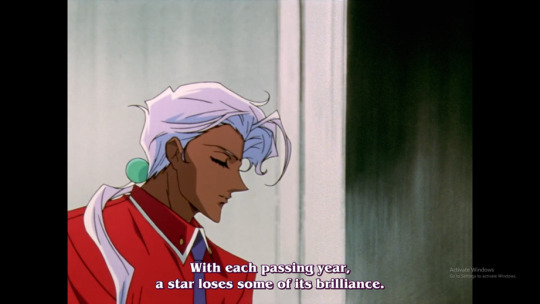
But let’s not forget why their journey is as it is: Kyubey’s request for them to be magical girls. What does it say that the life he’s pushing them into echoes Akio’s worldview? I also find worrying this line finds a clear parallel to their soul gems losing clarity. Really fishy.
If we are to go by Mami’s death, then that something lost is idealism. Her death marks a departure from the rose-tinted view of the adventure-filled life of a magical girl to one marked by grim consequences. Homura reinforces this by saying “Engrave this moment in your memories, this is what it means to be a magical girl.” In Homura’s view, the processual search of destabilizing change towards adulthood is irremediably traumatic. Mami’s demise certainly complicates the linear view of growing up as a gradual, progressive process towards adulthood[1]. The child might not merely be shielded from the horrors of the world and be filled with the appropriate knowledge and guidance to become a full-fledged member of society.[2] Furthermore, as shown in episode three, Mami’s own self already contained contradictions to these ideal conceptualizations of the child and the process of growing up as actualization of the self and reproduction of the communal future. What answers and further inquiries this questioning of adolescence yields in Madoka Magica is what I set myself to discover. For now, our heroines are first faced with the darkness of the world.
The environments reflect this increased sordidness. The darkness of the cityscape becomes deep, nearly swallowing our heroines. The aggressive reds to the sunset forebode danger. The nearly interminable bridge from which our heroines emerge presents a long way to safety, framed by withered tree branches.
[Image ID: Pictured of a really ominous red bridge that casts deep shadows towards the left. It’s placed so that it its center goes over the point of fugue, where the distant figures of the trio are placed. In the background, the dark city line looms against the twilight sky.]
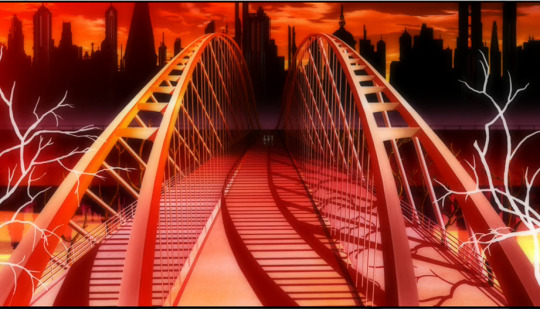
The underexposed framing flattens perspective and casts them as mere shadows that could get lost in the regular, geometric darkness of the city.
[Image ID: Screenshot to the trio crossing a bridge headed to the left. Their bodies and the bridge appear shadowed with only their black silhouettes showing. The lamp posts are spaced evenly and cables that hold the bridge form rhomboids that also appear evenly. The sky is colored in an aggressive dusk and the faint city line in a purple shows in the background.]

The wide-angle look at the metallic interior of the building, framed by broken crystals, is intimidating and uninviting. In short, it’s as though they’ve stepped into another, darker, parallel dimension to their world.
[Image ID: High, wide angle shot framed through curved broken glass of the interior of the abandoned complex where Gertrude manifested. There’s a shining metallic corridor and some stairs going down.]

The whole city is in flux once the twilight sets, transforming it from the luminous, safe gardens of Madoka's home and the school to a place where danger lurks in the shadows. Dusk itself has historically been constructed as a liminal time, a time where it's not quite day and not quite night, a time encoded with the thinning of boundaries between the worldly realm and the supernatural one (After all, ōmagatoki is the time when yōkai wake up and are able to move freely between worlds.) The confrontation with witches heightens the liminality of adolescence, where they move from childhood innocence and ignorance towards facing the more unsavory realities of the world. Their perception of their familiar, safe hometown is altered.
Yet, amidst all this bleakness, Mami still stands tall as a beacon of righteousness.
[1] Balanzategui, J. The uncanny child in Transnational Cinema: Ghosts of Futurity at the turn of the Twenty-First Century. Amsterdam University Press, 2018. P14.
[2] Balanzategui, 2018, 10
Competition, Cooperation and Social Conventions.
Mami fits the well-mannered, soft-spoken and helpful upperclasswoman archetype to a tee. As such, she’s adept at navigating social situations gracefully and reading between lines, as well as prioritizing unity and avoiding unnecessary strife. This creates a stark contrast between her and the extremely off-putting Homura, who could be said to embody the anti-social, rival loner. We’re introduced to their tense dynamics when Mami gets in between Homura’s hunt of Kyubey in episode one. I can’t really parse if Homura ignored the subtext behind Mami’s polite dismissal on purpose, but it’s a recurring theme in their interactions:
Mami: The witch got away. If you want to hunt it down, you’ll need to chase after it quickly. I’ll give you this one. Homura: I’m here on business. Mami: You don’t seem to understand me. I’m saying I’ll let you go. Would it not be better for both of us to avoid any unnecessary trouble? (Homura reluctantly leaves after a few moments of tense, silent staring.)
Since Homura either ignored or failed to catch the true meaning behind her polite words, to read in between lines and act accordingly to avoid unnecessary strife, Mami had to explain her point directly. Depictions of and commentary on these types of social conventions— the molding of one’s behavior to be directed according to heteronomy rather than autonomy, the avoidance of conflicts and confrontation, and the indirect expression to avoid hurting others— and how failure to conform to them can bring in ostracism abounds in Japanese media (for an extremely well-liked example, think on Mob Psycho 100’s episode three, where the whole cultish group-think is what sets Shigeo off and reminds him of his painful experiences being mocked of for being unable to pick up the mood of the room).
I previously speculated that Homura might be cultivating an intentional distance between her and Madoka, but her interactions with Mami also show that Homura can’t help this distance at times. While she purposefully rejects Mami’s show of good will through the passing of the grief seed in episode two and curtly questions Mami’s intentions in the third, she appears thoroughly unprepared for the tensions escalating in Charlotte’s Labyrinth. Almost as if she hadn’t foreseen that the tensions boiling over could lead to her becoming immobilized. She’s unable to navigate the situation to successfully offer to take out the witch, and nearly jeopardizes her own mission to protect Madoka. Put in very simplistic terms, you can’t act together with other people if you don’t adhere to social conventions in some shape or form. Homura wants to favor acting alone (she wants to shoulder everything herself?) and is single-minded in her desire to protect Madoka, not caring if she’s misunderstood. I suspect this rejection of cooperation might be bringing in some of her failures.
[Image ID: Overhead, fish-eye frame of the girls at the abandoned complex where Gertrude manifested.There’s wide, tall window panels on the left edge, where Madoka, Sayaka are postioned towards the bottom edge of the screen. Over the picture’s diagonal, across from there, is placed the lone figure of Homura standing before a dark corridor. Mami’s dialogue reads: “Or do you dislike sharing with others?”]

Sayaka, Madoka and Mami are portrayed as a cohesive group, visually separated from Homura by the shadows of the pillars and the physical distance between them being amplified by the fish-eye perspective. Mami outright questions if Homura is selfish, read: unable to consider others’ feelings and adhere to a group.
As the newbies role model, it goes without saying that Mami is able to “consider others’ feelings” and “read in between lines”, as these are qualities that are enforced as desirable, especially for girls and women… In order to serve as an appropriate guide for Madoka and Sayaka, Mami must maintain social propriety. Interestingly, this ends up also distancing her from her juniors; it’s not a total departure like with Homura, but it does parallel them as lonely figures.
[Image ID: Screenshot of the shadowed figures of Mami, Sayaka and Madoka crossing a stone bridge towards the left. On the edges of the screen, the city lamps are lined and insinuating the point of fugue. The blurry, dark building line can be observed in the background. Mami walks ahead of Sayaka and Madoka, who trail behind.]
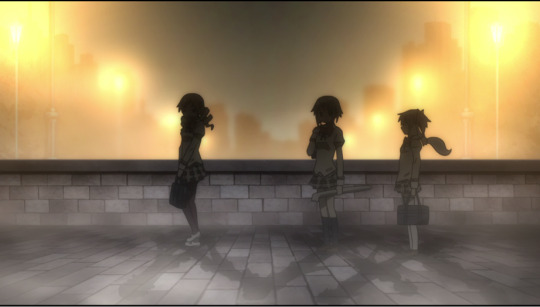
The distance that never seems to close. If Mami is to appropriately act as their senpai, she must walk ahead of them. We know, of course, this causes incredibly pain. Observe how obscuring their figures in darkness makes the negative space between them stand out.
A witch’s domain.
Now, we’ve finally arrived to the reason why I wanted to do these write-ups to begin with: I thought challenging myself to interpret the witches’ Labyrinths could be quite fun, and then I stumbled upon the fact Madoka Magica is quite the rich show with lots to discuss about it. But I digress. I quite like the aesthetic of the Labyrinths, they have a collage look to them that could remind you of the collages of the early XX century, as explored by Picasso, Juan Gris and other vanguardists. You could even call them surrealist in the way they utilize mundane objects in a profoundly disorienting way, elevating them from their prosaicness into symbols of the witchly subconscious.
[Image ID: Picture of Juan Gris’collage made with cut-and-pasted wallpaper, newspaper, transparent paper, white laid paper, gouache, oil and wax crayon on canvas. It depicts a table with filled to the brim with coffee-drinking accessories. A fortuitous newspaper fragment provides the ready-made signature “GRIS” while the letters “OURN”, excerpted from the masthead of Le Journal, form a homophonic on “Juan”.]

Collage by Juan Gris: Título «Le petit déjeuner».
Once again wondering if I should read more about (vanguardist) art for the sake of this show.
Speaking in crude, overly simplistic terms, the vanguardists’ formal artistic exploration was a departure from the European academicist tradition. While the Impressionist movement already exposed a rift between Academy and Artist, it still sought to portray realistic, figurative impressions of the world. Post-impressionist artists such as Cezanne and Van Gogh pushed the treatment of color to exaggeration for the sake of a heightened subjectivity. Cubist art sought to challenge representational conventions through use of simultaneous perspectives that showed the static object in all of its different angles at the same time. One of the most famous surrealist paintings of all time, René Magritte’s The son of man, exemplifies his career-long questioning of the assumptions of representational art—what you see in the canvas is not the object but a symbolic representation of the object, and the symbol of the object does not represent the object but all the subconscious meaning imbued to it by the viewer. The painting exploits the quality of visible and hidden, and the search for what is hidden.
It is, then, fitting that the Labyrinths seem to borrow vanguardist aesthetics, as they defy perceptions of reality— to begin with, they are crafted in entirely different stylistic conventions. The character designs and backgrounds outside of the Labyrinths favor bright, cool, uniform color with thin line-work, creating well defined and recognizable forms; the human characters are portrayed with slightly doll-like shapes while still favoring “realistic” proportions, and the backgrounds are represented in geometric perspective. While stylized, it’s a world that clearly echoes our own. The witches’ realm seem to discard all of this, operating on their own logic. There’s no sense of uniformity to its elements: some will appear as heavily-textured, flat magazine cutouts while others will appear as highly uncanny cgi objects. Most of its denizens hardly appear anthropomorphic, and when they do in some of the witches, they appear in cartoony proportions reminiscent to Fleisher era cartoons rather than 2010’s anime stylizations (at least in the case of Charlotte). Their bodies are either deceitful or incomprehensible. This seeming incongruence makes our heroines themselves appear alien against the uneven patchwork of this world. The witches’ realm seems to question their way of being just by its own aesthetics alone.
[Image id: Screenshot of Getrude’s Labyrinth. In the background, there’s backward stairs to the left edge, tilted columns of varying width with framed moustache pictures, an unreadable sign, and an upside down elevator going down to the right margin. The trio is on the middle ground towards the left. Sayaka is swinging her bat in the middle, Mami is holding guard of the left edge and Madoka is standing between them cradling Kyubey in her arms. The foreground is insinuated through the shadow silhouette of some tilted beams.]
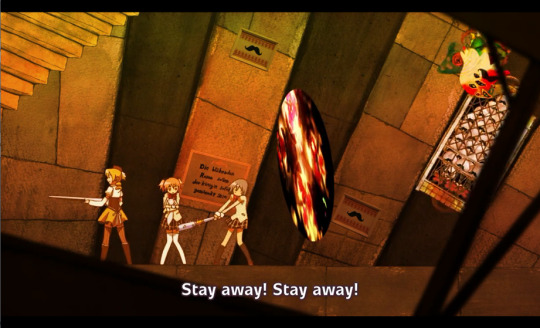
Common sense is eschewed, and you get tilted walls and columns, upside down stairs, out-of-place elevators.
[Image Id: Screenshot of Mami and Madoka traversing a black space with no clear horizon line, in which the first half of it is like black mist transitioning to a really bright, white equally misty middle. The foreground is indicated by a layer of cgi medication bottles haphazardly floating, and so is the background behind them with more bottles looking smaller and blurrier.]

They’re places that seem to simultaneously exist as flat, two dimensional spaces and as tridimensional ones. They’re places that embody contradiction, and encoded in their corpus are distinctively feminine motifs (think of the rose garden, the cake and tea parties, the home décor, the high heels, etc) made alien through their unreal representation and co-existence with masculine motifs (such as the fake ‘staches and industrial/handiwork symbols). The national and the foreign coexist as part of a whole. They’re places that “don’t respect borders, positions, rules. They’re the in-between, the ambiguous, the composite[3]”. They’re geography made the monstrous-feminine.
[Image id: overheard shot an intersection in the middle with the girls turning right, there’s tall, rusty-copper-like buildings seemingly made out of metallic plates with doors randomly thrown in all over their body. To the foreground, on the wall insinuated the bottom edge, there’s vines or perhaps security wire.]

The alienating, featureless cityscape and the overtly adorned rose garden. The public sphere and the domestic realm exist without clear delimitations.
[Image id: The trio running towards the left over a metallic corridor with vines rose vines coming out of the ground and going towards the edges. In the background, there’s a collage-like semicircle that looks like a rose wallpaper wall crowned by some stairs, the wall is on top of a green patch with rose bed in the middle. In front of the rose bed, there’s a door adorned with curtains and the like.]

“The female body in the Japanese pop cultural imagination is routinely constructed as a site that is volatile, uncontainable, penetrable and penetrating, incorporating, excessively desirous, and unrelenting generative, demonstrating Creed’s[4] contention that the monstrous-feminine ‘signifies the primal uncanny, in that through her body everything that ‘ought to have remained secret and hidden… has come to light.’ Those things that patriarchal culture seeks to keep hidden involve man’s relationship to the animal world, the world of nature, woman, life, birth, decay, and death”:[5]
Far from aligning myself with the common detraction that Madoka Magica is bad because it’s perverted (like its main writer is), I think it’s interesting to note that witches do carry insinuations around female sexuality in the vampiric implications to the mark in the neck the witch’s kiss leaves behind. That it was left on a working woman insinuates anxieties around female homosexuality (the mobilization of sexual difference through the Monstrous-Feminine is also a common trope). I don’t really have enough to go by to form an interpretation, but it’ll be interesting to see how these element unfold.
Also, speaking of the world of nature, Gertrude body’s is not only not anthropomorphic (it could be argued she’s some sort of bush connected to a stomach?), but also features animalistic traits in the butterfly wings and her behavior.
[Image id: Screenshot to Getrude sitting in the middle of the frame, surrounded by roses on top of a green patch. Around her there’s several miscellaneous objects, like black bollards topped with sphere sporting black ‘staches, a framed butterfly, ladders, black plants, a fish placard, several other butterfly motifs, etc. Behind here, theres several curved layers creating a textured wall. They look like a metallic fence, fragment of wallpapers, concrete walls and other type of buildings.]
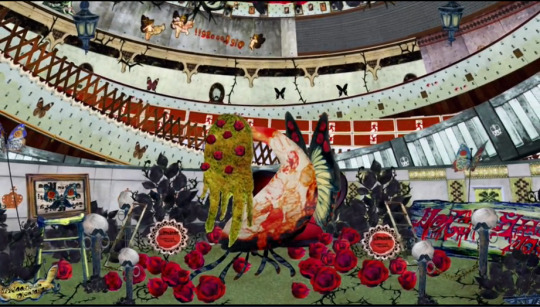
“The abject confronts us, on the one hand, with those fragile states where man strays on the territories of animal. Thus, by way of abjection, primitive societies have marked out a precise area of their culture in order to remove it from the threatening world of animals or animalism, which were imagined as representatives of sex and murder.”[6]
The fact that our resident, well-mannered senpai Mami, as an agent upholding social convention and model of femininity, is the one to defeat Gertrude, an animalistic, vermin-like presence in the rose garden, a space that could be constructed as the domestic realm, feels charged. I generally view the Labyrinths as spaces meant to challenge their perceptions of reality, in a much more extreme, destabilizing and disconcerting version of Madoka’s careful contemplation of differing viewpoints. The tensions brought to the surface in each Labyrinth then are dependent on who interacts in them, and as such, my view on Gertrude defeated by Mami is that of reflecting Mami’s certainty in the values she upholds. Even when her juniors catch her off guard, her home is impeccable and she has dessert and tea to offer them. Her maintenance of the home and social conventions aren’t threatened.
At least not in at this point of time, but her dialogue in Charlotte’s Labyrinth reveals a possible destabilizing contradiction. She tells to Madoka that being a magical girl is not desirable because “(Madoka) won’t have time to fall in love.” Their role as magical girls might then paint them as proto working-women, in conflict with their supposed belonging to the domestic sphere as “wives and mothers”. It might not be inappropriate to suggest that the blurring of public and private spaces in the witches’ realms might be articulating anxieties around working women.
A final note, more miscellaneous note on the nature of the witches and their Labyrinths comes in the form of the visuals for the defeated familiar in episode three. The vestiges left by it bring to mind pollen or perhaps viruses, and together with the vampiric implications of the mark of witch’s kiss, it might seem to paint witches as something contagious. I wonder if we’ll get into social contagion territory eventually.
[Image id: screenshot of brightly, multicolor, amorphous particles floating around against a black background with the faint outline of a grid at the very background. Some of the particles look like the popular image of viruses.]

[3] R. Dumas, The monstrous-Feminine in Contemporary Japanese Popular Culture, East Asian Popular Culture series, Palgrave McMillan,2018, P2
[4] Barbara Creed published in 1994 her essay The Monstrous-Feminine: Film, Feminism, Psychoanalysis. Her work is often cited in Dumas’ opening essay Open Wounds: Situating the Monstrous-Feminine in Cotemporary Japan to her book The Monstrous-Feminine in Contemporary Japanese Popular Culture. The quotes here included are from Creed’s 2005 book Phallic Panic: Film, Horror and the Primal Uncanny.
[5] Dumas, 2018, 17
[6] Julia Kristeva, Leon S. Roudiez, Powers of Horror, an essay on Abjection, Columbia University Press, 1982, 12-13
Mami the girl.
Last time, I discussed the fact Mami wanted to appear as their put-together, helpful upperclasswoman, as a more adult guide to their wet-behind-the-ears candidness. Her fight against the witch’s familiar in episode three confirmed my suspicions. She does an explicit effort to appear cool, to answer their questions so that they can carefully weigh their decision— even when it touches on her open wounds— and to advise Sayaka against helping others just to feed on her own ego. She goes above and beyond to be a proper senpai to them.
[Image id: Close up to Mami’s face. She’s smiling and winking while tilting her head slightly. The lighter from her finishing gun is visible and going off. She’s in her magical girl outfit.]

Episode three, however, also shows the crack behind the façade, starting by Mami’s troubled past. If being “a child is demarcated by characteristics such as innocence, naivety (…) and vulnerability”[7], then Mami is forced to be more adult-like following the accident and her subsequent metamorphosis into a magical girl. Mami’s seeming maturity is, then, abruptly forced upon her rather than gradually grown into. Her vulnerability (she’s literally mortally wounded and also all alone with the loss of her family and lack of any other external support network) in the moment to make the contract puts her in the spot and forces her to accept Kyubey’s offer. As a result, she’s denied the luxuries afforded to Madoka and Sayaka. She’s denied to show any of her weaknesses and pain to others. To grow up is to lose something. The loneliness she exhibits as their role model is not solely stemming from her position as their upperclasswoman but her quality as a magical girl itself.
Further fractures into the image she wishes to project to the world are brought to light through her confrontation with Homura. Her politeness, supposed mark of her preference for unity and peaceful negotiation, is more markedly shown as a tool to express her aggression through thinly-veiled threats and nasty condescension. The visuals play with this obliqueness of hers. When Homura is upfront about accusing her of leading Sayaka and Madoka into danger and her desire to prevent Madoka from forming any contract, her face is shown in a mid-light value, while Mami’s face is markedly shadowed in her taunting retort.
[Image ID: Bust of Homura with the night sky on the background and some lamps lighting from behind. She’s dimly lit (with very readable shapes). She has a serious expression on her face. Her dialogue reads: “She is the one person I absolutely cannot allow to make the contract.”]
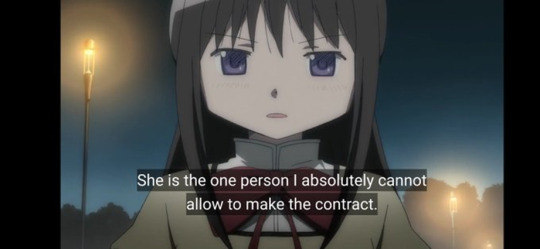
[High-angle shot of Mami’s bust. She’s looking up,smiling defiantly and cast in dim shadows. Behind her, only the grey stone of the plaza ground is visible. Her dialogue reads: “That’s the way a bullied child thinks.”]
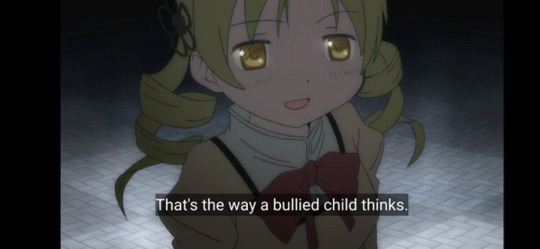
Conversely, when Mami is clear about her warnings to Homura, she’s showered in light, while Homura’s reticence to be clear about her intentions has cast her in hard shadows.
[Image id: Extreme close up to Homura’s face, which is about 75% cast stark shadows with sharp lighting on the right side of her face, the right side of her nose and her left cheekbone. Her expression is harsh.]


[Image id: High-angle shot of Mami standing upright and smiling while standing in a dark plaza. She’s well-lit by the lamps around her. Her dialogue reds: “Then take care to ensure that our paths never cross again.”]
Mami shows discomfort at Homura’s accusations, but shields herself in the justification that since Madoka and Sayaka have been chosen, they’re not innocent bystanders anymore, and thus involved in this whole business.
A common thread within the show seems to be the embodying of contradictions and ambiguity, of identities in flux. Homura is both a hostile, antagonistic party and someone who sincerely wishes to shield them from tragedy. Mami is both protecting them and luring them into danger. Sayaka is both more pragmatic than Madoka and more immaturely simplistic. Madoka is both idealistically naïve and sagaciously capable of contemplating and contending with uncomfortable, conflicting feelings and viewpoints. The instable, disorienting nature of the Labyrinths would seem to heighten these tensions and paradoxes to the point of collapse.
Charlotte’s Labyrinth exploits the disparate, showing a composite of medical motifs combined with the (feminine) domestic realm: bottles of pills (filled with candy), piercing objects ranging from the sewing needles and scissors (of a sewing kit) and the syringes of the clinical setting (it pains me to write this, but you could make a point to call these penetrating needles phallic). The hospital as a workplace and a public facility juxtaposed to the sewing kit and the desserts motifs (that slowly morph into being vaguely birthday themed through the cake with candles and the tea party) showing the private. The mature bleakness from medical setting vs the childish happiness and flippancy from the party. The visible and the hidden.
It is within this space that Mami finally admits to her “adult” self-assuredness and competency being a façade through a fit of oversharing. It is not a considered reckoning of her own weaknesses as much as an impulsive, resentful reaction to Madoka’s idealism. Her vulnerable confession—its climax is literally a promise of forming a new coupled partnership with Madoka’s unending support. You could say: a promise of true love and acceptance outside the social system— is accompanied by a bevy of pills raining down in the background. The contradictory strikes again: even though pills are meant to heal, their cascading number evokes suicide. Even though it’s a moment that should’ve resolved some of her internal tensions and healed some of her pain, it instead spells her death. Mami launches to her hunt of the witch in a euphoric state, clinging at the first offer of happiness she gets; much like the recklessness she warns her juniors against when it comes to their contract with Kyubey. All of her talks of post-hunt celebrations seem to mirror the childishness of Charlotte’s realm. She jumps into action recklessly without assessing the situation, in contrast to Homura’s measured, methodic approach later on. Perhaps one could read her defeat here as her failure to acknowledge and reconcile with the fact her roles as a magical girl and senpai aren’t mutually exclusive with her own childishness, her ideals aren’t without hypocrisy and harm, and so on.
[Image Id: Close up to Mami’s outstretched hand in front of her middle, with her palm up. In the center of her hand, a ring glows, and around it petals emerge in the form of a daisy.]
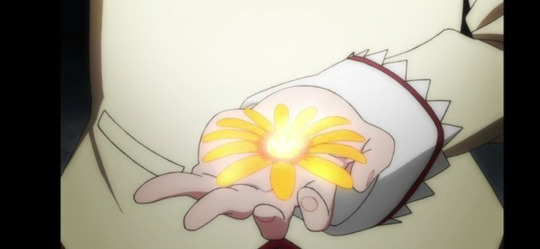
In Hanakotoba, daisies symbolize hope and peace.
Her death reveals further fissures to the idea of “growing up (as) wedded to ideals of collective progress, as the child’s journey towards both adulthood and futurity (…) through continual progress”. [8] This failure to eventual realization brings in questioning Mami’s experience as a magical girl— one in which Mami does a service to society at large, but at the cost of finding herself unsupported and isolated by the very need to produce these communal results. Her death epitomizes the harm this contradiction creates, the impossibility for the child to live a future when her growing up is always functionally at service of others (Also Madoka’s flaw?)
[7] Balanzategui,2018, 10.
[8] Balanzategui,2018, 14.
Miscellaneous.
My friend asked me my thoughts about the first opening (I’m expecting a new one on the fourth chapter) and first two endings. So here’s that.
Ending 1 (See you tomorrow by Aoi Yuuki): I find this one really amusing because 1) It’s sung by Madoka’s seiyuu, and 2) she sounds like a baby. It sounds really cutesy overall, so the whiplash with the lyrics is very pmmm-like lol Lyrics about loneliness and feeling alienated in your hometown and never seeing someone again. Which could mean nothing.
Opening song (Connect by ClariS): Now, this one does communicate the melancholic vibe through the sound and singing, and despite the cute, cheerful adventure vignettes, it does have some pensive Madoka scenes. I like it, the lyrics reflecting that yearning for “a start”, and the promise of perseverance. Feels very Madoka.
Ending 2 (Magia by Kalafina): This one is pretty cool, I like Madoka’s silhouette walking past the static figures of her friends and leaving them behind towards an unending darkness, where she breaks into a run. The final image having her in fetal position as an eye open combined with the heavy drumming and the bells tolling create such a feeling of impending doom, it’s so great. I’m a little amused the lyrics talk about world-destroying love and a thirst for power, it’s cool.
Afterword.
Firstly, a thanks to my friend, you know who you are, who read the endless updates to this document as I kept working on it. I don’t think I’d have finished it without the encouragement.
Secondly, I ended up excising a few points from this write-up, namely observations on the intro scenes with Sayaka and Kamijō, on the framing between Sayaka and Madoka right before they venture into Charlotte’s Labyrinth and on Madoka’s talk with her father and her construction as an ideal. Mostly because I got tired of working on this, but also because it has gotten quite long and I couldn’t quite fit them with the themes of the present sections. I’ll probably include them in the write-up for episode four.
#pmmm#puella magi madoka magica#mami tomoe#sayaka miki#homura akemi#madoka kaname#fsahfsfh writing those ids for the labyrinths was so haaaard lmao#lost post#this one has one sixth less pictures but more text lol#realized this thing still has typos even after all the revisions lol it's so over...
16 notes
·
View notes
Text
How successful would Sayid Jarrah…

Would you like to submit a character? Click this link if you do!
#could they be a pro wrestler#sayid jarrah#lost#lost abc#lost au#lost sayid#naveen andrews#lost tv show#lost tv series#lost series#lost season 2#lost show#lost post#abc tv#lost island#lost lore#sci fi series#lost 2004#tumblr polls#polls#character polls#fandom polls#wrestling#poll time#wrestling polls#poll game#hyper specific poll#wwe#professional wrestling#pro wrestling
21 notes
·
View notes
Note
What's your favorite Venti lore/references?
For me it's him guiding souls after death and being connected to istaroth. Also the whole prodigal son thing, What do you think it means for him? (Hope you don't mind getting asks like this, i couldn't help but be curious)
CRACKS MY KNUCKLES. ALRIGHT FOLKS, BUCKLE UP.
DEATH
First off, I absolutely love his ties to death! Usually in media, when gods deal in the realm of death, they're all dark and dreary and either sad or evil. Venti, on the other hand, embodies more of the aspects of comfort. A final rest after a life well lived. Barbatos is said to guide the souls of the deceased to the afterlife on a wind, yes, but he also lets them live on through song! There is a belief that someone isn't truly dead until their name has been spoken for the last time, and Venti places importance of using names in his songs, as seen in the manga when he asks Venessa if he can use her name in a song.
There's also how heavily anemo ties into the concept of loss (gestures at the dead friend gives you an anemo vision joke), and the anemoi wind spirits from myths were also once a guide of souls to the afterlife.
There's also the post I made last night- "Not death, but his brother, sleep" (shout out to The Ra.ven Cycle book series). In Greek mythologies, which Venti does have a few ties to, Death and Sleep are brothers- and we all know of Venti's ties to sleep. Aside from his times of sleep, he was also seen singing the guards to sleep when going to free Venessa.
ANYWAY all this to say I think along with the wind, freedom, and hope, death is one domain that Venti falls into. (Which just makes him and Hu Tao even better buddies).
ISTAROTH
This is where I can more theory crafting rather than reflective. We've learned the the Thousand Winds were the Thousand Winds of Time. Now, I do not think that Venti is a son in the traditional sense- rather, I think that the Thousand Winds of Time form one being- Istaroth.
Venti also called himself a single breeze/wind, so I believe he was one of the thousand that made up Istaroth, only to rise up above the others in terms of power during the rebellion against Decarabian, and then becoming a god in his own right.
Do I have much evidence for this? Not at all! It's just my thoughts.
(Also, apparently prodigal means wastefully extravagant, which while I admit my first thought is his indulgences in drink and revelry, also make me wonder if it is perhaps that he has made Mondstadt into a home where people can act as such if they please- free to do so.)
OTHER THOUGHTS
One of my favourite bits of lore comes from the Wings of Shimmering Galaxy lore. It's spoken from the perspective of Venti post Archon War! It goes to say,
"For he knew that someone must heal the hurts of the world, and thus someone needed to find a way to communicate with them."
From Zhongli's character stories, we know that Venti went to visit, bringing a gift of wine- and that that led to the 7 all meeting together regularly. He is a bard, and the god of the wind- music and poetry flow like the wind, after all. Of course he would facilitate communication! HOWEVER, this didn't work for a long, long time. In fact, the glider lore continues,
"But the poet knew this would happen. (...) Still, the poet did not give up, though not because he believed or anything. This was just the way he was."
Despite being called the god of Hope by Neuvilette, Venti didn't have any hope. He just... didn't know what else to do.
Anyway, I should end it here, before I ramble on for many more paragraphs about all the things I love about Venti.
66 notes
·
View notes
Text
✨Writer intro post✨
G'day, I'm Jay! I'm an Australian writer and artist, and I'm currently working on two stories: "The misfits.", and "The Narrow Road."
"the misfits." is a story about love, hope, forgiveness, and learning how to have a little bit of faith. From the outside, the "misfits" (as they call themselves) seem to be a band that has got everything together- but everything is not as it seems. Faith, the leader and singer of the band is hiding childhood trauma. The rest; Dante, Katelyn, Nicki and Noah, are dealing with problems of their own. When they meet Bryson, a closed off musician, they become fast friends through their love of music. Can the 6 of them prove that love, hope and a little bit of faith is enough to heal a broken heart? (on Webtoon!)
Mood board:
Song:
"The Narrow Road" is a story of redemption, family, and learning that no one is too far gone. Jamie is a headstrong and rebellious college drop out that has had way too many second chances. When one of his stunts ends up with him volunteering at the local church, he meets JD, the daughter of the pastor. With a newly made group of friends, he'll learn that the narrow gate isn't always easy, but it's worth it in the end.
Mood board:
Song:
If you have any questions about my stories or OCs, feel free to ask! 😄
#oc#ocs#original story#original character#story#character story#my writing#writing#writers on tumblr#writeblr#writerscommunity#ao3 writer#female writers#writer intro#writeblr intro#intro post#original character oc#originalcharacter#Spotify#lost post#my ocs#my ocs <3#writing stuff#writer stuff#creative writing#christian writer#ao3 author#ao3#indie writer#writers of tumblr
16 notes
·
View notes
Text
Lost Post
Reward: A singular cat picture. She's cute, I promise.
I saw this Batfam post a little while ago about Bruce's reaction to everyone calling him "Dad" and it's been in my head for the past three(?) days and I miss it.
Can't stop thinking about it :(
#batman#batfam#lost post#PLEASE#I saw it and didn't reblog and it's my greatest regret thusfar#dc#dc comics#dcu
26 notes
·
View notes
Text
Looking for a post dcxdp
Danny is at a gala and so is Damian -NOT RELATED - and they basically start a game where they have to poke someone without them knowing as a stab and Danny says something about giving him something if he can get Vlad and later Damian spots them leaving and Danny looks scared
At some point he sends an ice dagger also Danny has a tracker in his ankle
#dc x dp#dcxdp#dc x dp crossover#dcxdp crossover#lost post#please help#pls#damian wayne#danny fenton#help#can't find it#goodbye#bye
169 notes
·
View notes
Text
2024 Tumblr Top 10
1. 2,549 notes - Aug 30 2024 Cotl animated wip
2. 594 notes - Aug 18 2024

3. 573 notes - Aug 3 2024

4. 373 notes - Sep 13 2024
5. 348 notes - Aug 5 2024

6. 311 notes - Nov 23 2024 another short peek at the Cotl animatic-
7. 310 notes - Jul 16 2024

8. 253 notes - Aug 14 2024

9. 128 notes - Dec 13 2024 moongazer and his boys doin Cotl thangs.
10. 111 notes - Jul 7 2024

Created by TumblrTop10

not surprised that it’s mostly CoTL stuff- the first wip video really took off aHA! I just hope y’all saw the final video.
Super cool that some of my ArtFight attacks ended up on here, really proud of those ones.
#tumblrtop10#lost post#they're silly but i love these things#year in review#I think i did a lot more fanart last year then i usually do- I blame Moon#my art#i dont really care about note numbers- dont get me wrong. 's just fun
7 notes
·
View notes
Text
🥺🥺 PLEASE HELP ME FIND A LOST POST 🥺🥺
I was scrolling through Tumblr and someone had posted a series of photos of someone (possibly an actor?) and the post was about how this person had unknowingly been Remus Lupin for ages and no one had a clue.
The man has brown hair and one of the photos was him sitting in a bed with a laptop.
Can anyone PLEASE help me find it? 🙏
26 notes
·
View notes